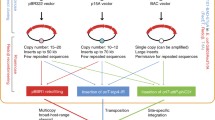Abstract
Red recombinase system of the λ phage is widely used for recombination of short linear DNA fragments and genome. Using this system, we obtained T7 RNA polymerase (RNAP) substitution mutants in Burkholderia cepacia. To test the expression abilities of the T7 mutants, four different lipase expression vectors were transformed and the lipase activity of these recombinants was evaluated. Our results suggest that 500 nt homology between the unit and the genome is sufficient to generate mutations and this strategy enables the rapid establishment of mutant strains with efficiencies of 85%. After expression and purification, the highest purified lipase activity obtained was 3,990 U/l, nearly triple that of the wild-type organism.




Similar content being viewed by others
References
Barnard GC, Henderson GE, Srinivasan S et al (2004) High level recombinant protein expression in Ralstonia eutropha using T7 RNA polymerase based amplification. Protein Expr Purif 38:264–271
Brunschwig E, Darzins A (1992) A two-component T7 system for the overexpression of genes in Pseudomonas aeruginosa. Gene 111:35–41
Chaveroche MK, Ghigo JM, d’Enfert C (2000) A rapid method for efficient gene replacement in the filamentous fungus Aspergillus nidulans. Nucleic Acids Res 28:97–102
Cheng HP, Lessie TG (1994) Multiple replicons constituting the genome of Pseudomonas cepacia 17616. J Bacteriol 176:4034–4042
Datsenko KA, Wanner BL (2000) One-step inactivation of chromosomal genes in Escherichia coli K-12 using PCR products. Proc Natl Acad Sci USA 97:6640–6645
De Soyza A, Silipo A, Lanzetta R et al (2008) Chemical and biological features of Burkholderia cepacia complex lipopolysaccharides. Innate Immun 14:127–144
Derbise A, Lesic B, Dacheux D et al (2003) A rapid and simple method for inactivating chromosomal genes in Yersinia. FEMS Immunol Med Microbiol 38:113–116
Gaffney TD, Lessie TG (1987) Insertion-sequence-dependent rearrangements of Pseudomonas cepacia plasmid pTGL1. J Bacteriol 169:224–230
Jörgensen S, Skov KW, Diderichsen B (1991) Cloning, sequence, and expression of a lipase gene from Pseudomonas cepacia: lipase production in a heterologous host requires two Pseudomonas genes. J Bacteriol 173:559–567
Lesic B, Rahme LG (2008) Use of the lambda Red recombinase system to rapidly generate mutants in Pseudomonas aeruginosa. BMC Mol Biol 9:20–28
LiPuma JJ (2007) Update on Burkholderia nomenclature and resistance. Clin Microbiol Newsl 29:65–69
Quyen DT, Schmidt-Dannert C, Schmid RD (1999) High-level formation of active Pseudomonas cepacia lipase after heterologous expression of its gene and its modified chaperone in E. coli and rapid in vitro refolding. Appl Environ Microbiol 65:787–794
Rosenau F, Jaeger KE (2004) Overexpression and secretion of biocatalysts in Pseudomonas. In: Svendson A (ed) Enzyme functionality: design, engineering and screening, 1st edn. Marcel Dekker Inc, New York, pp 617–630
Rosenau F, Tommassen J, Jaeger KE (2004) Lipase-specific foldases. ChemBioChem 5:152–161
Yang JK, Guo DY, Yan YJ (2007) Cloning, expression and characterization of a novel thermal stable and short-chain alcohol tolerant lipase from Burkholderia cepacia strain G63. J Mol Catal B: Enzym 45:91–96
Acknowledgments
We are grateful for the kind gift of plasmids by Dr. Laurence G. Rahme (Harvard Medical School and Massachusetts General Hospital, Boston, MA, USA) and Professor Karl-Erich Jaeger (Institute for Molecular Enzyme Technology, Heinrich Heine University Duesseldorf, Juelich, Germany). This work was funded by the National High Technology Research and Development Program of China (863 Program) (Nos 2006AA020203, 2007AA05Z417, 2007AA100703 and 2009AA03Z232) and the Program for New Century Excellent Talents in University (NCET-07-0336).
Author information
Authors and Affiliations
Corresponding author
Electronic supplementary material
Below is the link to the electronic supplementary material.
Rights and permissions
About this article
Cite this article
Jia, B., Yang, JK., Liu, WS. et al. Homologous overexpression of a lipase from Burkholderia cepacia using the lambda Red recombinase system. Biotechnol Lett 32, 521–526 (2010). https://doi.org/10.1007/s10529-009-0189-9
Received:
Revised:
Accepted:
Published:
Issue Date:
DOI: https://doi.org/10.1007/s10529-009-0189-9




